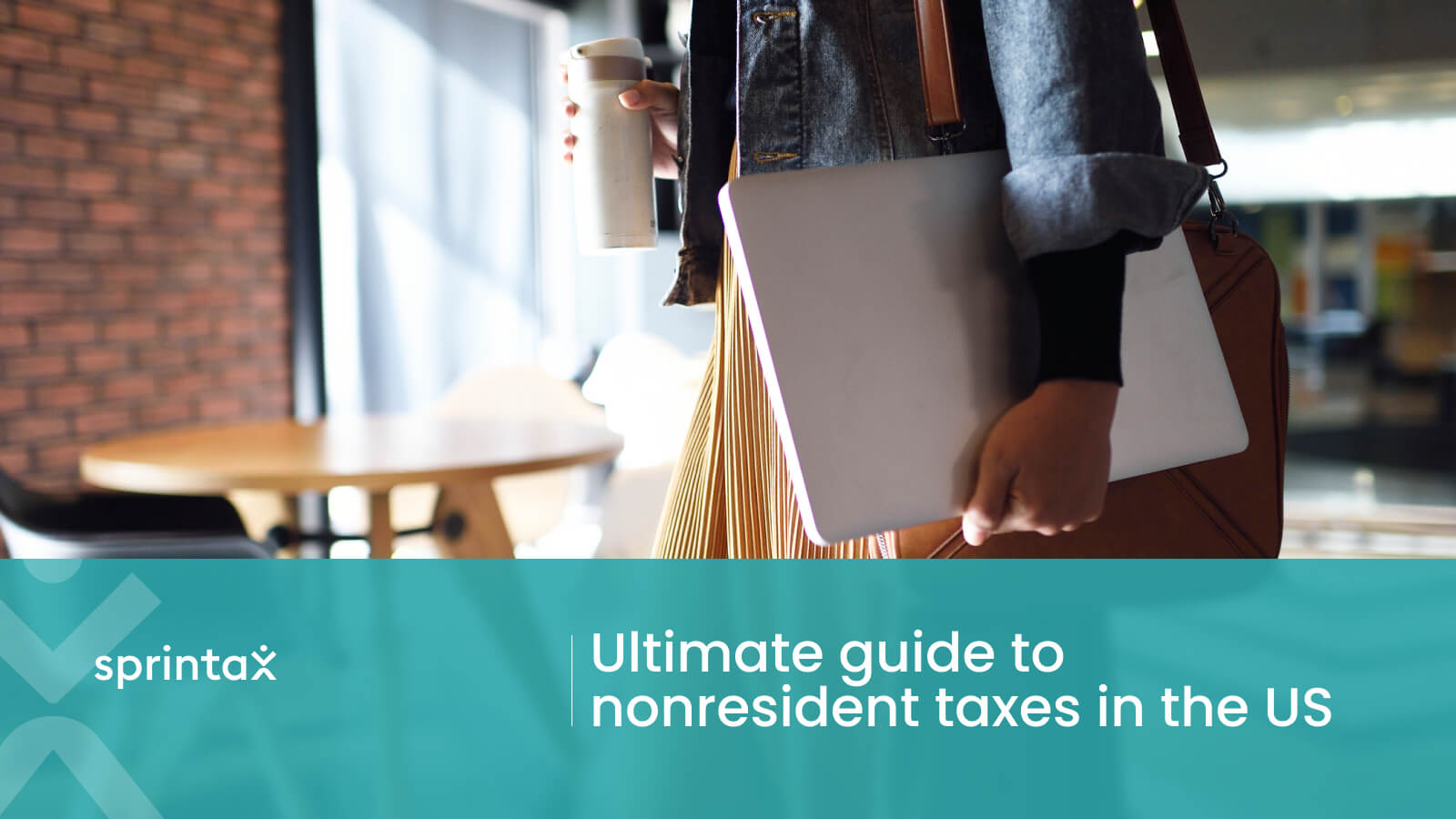

Whether you are dreaming of a trip to the US, or you are about to embark on one, the prospect of jetting off to The Land of Opportunity is bound to be exciting.
While you get to grips with the culture in the US, one area that often confuses nonresidents is tax.
That’s why Sprintax is here!
We specialize in making tax as straightforward as possible to newcomers in the US.
So, without further ado, here’s our ultimate guide to filing taxes as a nonresident in the US.

An alien is considered any individual who is not a U.S. citizen or U.S. national.
If you are coming from another country, you will be considered a ‘nonresident alien’ for tax purposes, unless you meet the Green Card test or what’s known as the Substantial Presence Test.
The same goes for those who are on F-1, J-1, M-1, Q-1, or Q-2 visas.
To meet the Substantial Presence test you have to be physically present in the US on at least:
You can read more in the IRS Publication 519, U.S. Tax Guide for Aliens.
For a nonresident alien, only income that is generated from sources within the US (excluding certain investments) is taxed. You can find more details about what income is taxed for nonresidents here.
A resident alien for tax purposes is a person who is a U.S. citizen or a foreign national who meets either the “green card” or “substantial presence” test.
Resident aliens, meanwhile, will be taxed on their worldwide income as if they were US citizens.

Nonresident aliens are generally taxed only on their U.S. source income.
They are subject to two different tax rates, one for effectively connected income (ECI), and one for fixed or determinable, annual, or periodic (FDAP) income.
ECI is the name given to all income from US sources that are connected with the conduct of that trade or business.
On the other hand, FDAP income essentially means passive income, which is any income that is from a source other than that of an employer or contractor.
If you live in the US or are soon to live there, you will have tax filing responsibilities.
There are two types of filing responsibilities you may have – federal and state level.
You must file Form 1040-NR, U.S. Nonresident Alien Income Tax Return, only if you have income that is subject to tax, such as wages, tips, scholarship and fellowship grants, dividends, etc.
Even if you didn’t receive any income, you must still file Form 8843.
This is often where nonresidents get confused – many are unsure what documents they need to file.
When filing your tax return, you may be asked for any of the following:
While you’ll need to file your federal tax return, the obligation to file your state tax return depends on the state you live in and the relevant rules there.
You can always choose to file your tax return yourself with the necessary documents, such as forms W2, 1042-S, and/or 1099.
However, many nonresidents choose to use Sprintax to file their tax returns!
Once you finish the easy Sprintax questionnaire and proceed through the order breakdown and payment stage, you will be ready to E-file your US tax return.
You will be required to provide an online signature and proof of identity before your return can be prepared.
As well as this, depending on the state that you resided in, you may have to file a state tax return.

The tax deadline generally falls on 15 April every year.
The deadline to file your U.S. nonresident tax return for 2023 tax year is 15 April, 2024.
If you owe money to the tax office and don’t file your tax return by this deadline, the tax authorities (IRS) have the option to impose delayed filing penalties and interest on the amount you owe.
It’s a good idea to try and always have your tax affairs in order before the US tax deadline.
That is because many nonresident aliens in the US leave their tax filing till late, and become overwhelmed with the unfamiliar process.
By not filing, you leave yourself open to penalties or fines from the IRS – the US tax authority.
This late filing penalty is generally 5% of the unpaid taxes for each month that it is late.
The penalty will begin the day after the tax filing due date, and will not exceed 25% of your unpaid taxes.
However, by filing more than 60 days after the due date or extended due date, the minimum penalty is either $485 or 100% of the unpaid tax, whichever is less.
It potentially could also impact the success of your future visa or Green Card applications.

Yes!
Not many nonresidents are aware that they can apply for a tax refund!
You can get a tax refund by filing a tax return.
The average Federal Tax refund with Sprintax is $1,004, while the average State Tax refund is $493.
The time it takes for the refund to arrive in your bank account depends on the IRS.
Normally, the processing time for paper tax returns is 4-6 weeks but it might take up to 6 months for the IRS to process the tax return and then send the tax refund.
That depends on your personal circumstances.
If you were married on or before the last day of the tax year, you do not have the option to file a return jointly with your spouse, if both you and your spouse are deemed as nonresident aliens.
If you file Form 1040NR, you will see that the only available option is to file as single on the tax return.
You can file a joint tax return if you or your spouse is a resident for tax purposes.
Sprintax has recently been approved by the IRS to facilitate Federal tax returns being filed electronically (also known as E-Filing).
That means it has never been easier to file your US Federal tax return from abroad!
If you also need to submit a state tax return, Sprintax can help you to prepare your fully compliant state tax return!
Then all you need to do is download, print, sign your documents, and send them to the tax office.
Yes, there are some tax exemptions that nonresidents can avail of.
For example, if you’re a nonresident in the US you may be exempt from FICA tax.
Those who are international students, scholars, teachers, professors, researchers, trainees, physicians, au pairs, summer camp workers, as well as other non-students on F-1, J-1, M-1, Q-1, or Q-2 visas can claim a FICA exemption.
As a full-time student, the exemption period is your first five calendar years of physical presence in the US, whereas if you are not a full-time student, it covers your first two years.

There are plenty of ways to reduce the tax you pay in the US.
For example, the US has tax treaties with around 65 countries across the globe.
These agreements allow nonresidents to be either partially or completely exempt from tax in the US.
If your home country has an agreement with the US, you can avail of these exemptions!
No matter what your job – can help you maximize your tax refund.

Below is a list of forms you’ll need to familiarize yourself with:
Form W-8BEN is generally used for claiming treaty benefits on income sources such as scholarship, royalties, or other passive income.
If you are in receipt of a taxable scholarship during your stay and are eligible to claim a tax treaty on this income, then you may need to fill out the W-8BEN.
This in turn can help to claim a reduced rate of tax withholding on your scholarship income if you are eligible to claim a tax treaty.
Form 8233 is used in order to claim a tax treaty benefit between the US and your country of residence.
This form is used to claim a tax treaty withholding exemption for part or all of your compensation from independent personal services, dependent personal services (or wages) and personal services income.
It may also be used for compensatory scholarship or fellowship income. E.g. If you are receiving a stipend or room and board allowance in return for performing services as a teaching assistant.
This is an annual tax form issued by your employer to show income paid and tax withheld.
If you received a scholarship, fellowship, grant, or any other source of US income subject to tax, this form is for you.
This form should be provided to you by whoever you received the income off.
You’ll need to know the W2 form if you work on or off-campus.
Your employer will give this form to you by the deadline and it will outline all your income from the previous year.
It is also divided into state and federal sections and there are fields with employer information and details of income.
If you received income from US sources other than employee salary, you will likely receive a Form 1099.
Basically, this is used to report rental income or income for services or commission for which you may have been paid.
There are several different 1099’s that report the different types of income you receive throughout the year:
1099-NEC records income you received if you are self-employed. You will be issued a 1099-NEC form by your clients if they have paid you at least $600 that year. Read more about the tax obligations of a self-employed individual here.
1099-DIV is issued to report dividends and distributions from any investments you received throughout the year. You must report the form on your tax filing.
1099-INT will be given to you if you have other forms of investments such as interest payments. You will more than likely receive the form from your bank where you have interest-bearing accounts.

This is not an income tax return.
You will need to file this form if you are in the US on an F-1, F-2, J-1, or J-2 nonimmigrant status and you are exempt for a certain period from a substantial presence test.
This applies whether you received US income or not.
You are also required to file this if you do not have to file an income tax return.
You will also need to file pre-employment documents – these ensure you claim tax treaty benefits and determine how much tax you pay.
Below is a list of pre-employment documents you may need to file.
You should use this form to file your tax return.
Form 1040NR is essential for figuring out if you are due a tax refund.
And remember, if you need some help with your taxes, you can easily prepare your nonresident tax return online with Sprintax’s 1040NR software!
The SSN is the most common type of identifier if you are allowed to work on or off-campus in the US.
Essentially, you won’t be able to work in the US if you do not have a number that the IRS can use to identify you for tax purposes.
When you are submitting your SS-5 you will also need to bring along some original documentation showing your age, identity, immigration status, and entitlement to work in the US.
Meanwhile, you will need to fill out a W-7 form when applying for an ITIN (Individual Taxpayer Number).

This is the start of the 2024 US tax year.
The U.S. tax year runs from 1 January to 31 December. This means you file your 2023 tax return in the 2024 tax season.
Tax season is when taxpayers prepare and file their income taxes. In the United States, the tax season is typically 1 Jan – 15 Apr.
Start of the 2023 tax filing season – the IRS will begin accepting 2023 tax returns.
This is the deadline to file your 2023 nonresident alien income tax return (form 1040-NR) and pay tax owed.
This is also the deadline to apply for an extension to file.
This is the tax filing deadline for you if you applied for an extension.
This is the end of the 2024 US tax year.
It is also worth remembering that if you choose to do quarterly estimated tax payments, then 15 April, 17 June, 16 September (all 2024), and January (2025) are the four dates to keep in mind.
You always have the option to file your tax return by yourself.
However, many nonresidents aren’t totally comfortable taking care of their tax requirements by themselves.
That’s why the best way to prepare your US tax return is with Sprintax Returns!
Our system ensures that you will prepare a fully compliant Federal and State tax return and maximize any tax refund you may be due!
What’s more – Sprintax is now approved by the IRS for E-Filing!
In short, this means you no longer need to download, print and mail a physical copy of your tax return to the US tax office.
Instead, you now have the option to file your federal tax return without ever having to leave the house!
So why not file with Sprintax today?